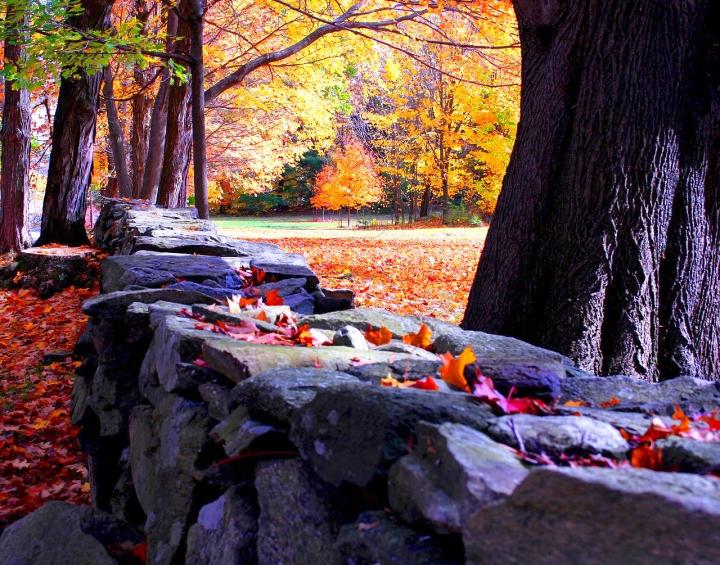
Got Rocks? Put Them to Good Use!
ADVERTISEMENT
Big rocks and boulders give structure to the landscape; keep the land from erosion; they serve a purpose in brooks too; making bridges for wildlife~
In my part of upstate NY across the border from Pennsylvania's Pocono Mountains we have sedimentary rock, often quarried from hill tops as "bluestone". On my property I have an old quarry and ,many visible layers and ledges of rock exposed on the hill sides. I have rock piles and old stone walls that some ambitious farmer built thinking that his fields would eventually be cleared but I'm still finding rocks that have pushed up since his time. I too separate out small, medium, and large rocks as I'm gardening or whatever to make good use of them. I really appreciate having them! I'm building my own wall across the front of the property and have made several raised beds with the stone I have picked. Laying stones is very relaxing, almost meditative.
When I dig a hole and separate the dirt from the rock the rock pile is twice the size of the dirt pile. Interestingly, every so often instead of the very common flat rough sandstone sedimentary type rocks I'll find round smooth non-sedimentary rock. I'm not sure what type of rock those are as I'm no rock hound. But I do recognize that some ancient geologic process put an oddball where it stands out for me to find and ponder about.
One ruse I pull on more gullible folks who ask what I grow on my property is to tell them I grow rocks. Wide eyed in amazement they ask how I do that. So I tell that in the fall I scatter a five gallon bucket's worth of little gravel and pebbles all over my property. Then I come back in the spring and all the pebbles and gravel have grown into big rocks that I then pick up to use on my walls or in my garden. Sadly too many don't understand the natural process that's really going on and believe me.
I once left a perfectly fine pair of sneakers in New Mexico to make room for the rocks I collected, while on vacation.
I'm from Yorkshire - google drystone walls
I have gathered rocks from all over, from bigger than a bowling bowl to collecting buckets of smoothed, multicolor rocks along the lakeside shores, now added to a gravel bed to give depth and interest. Found people giving away rocks online - got plenty that way. Picked up rocks here and there from special locations as a "souvenir", which then goes into the garden. Rounded up many that are big enough to use as a border, all different, which looks great. It was many years of collecting. Every flower bed has rock accents, which allow for visual interest during the changing seasons as flowers grow.
I too experience calm when arranging river rock around my northwoods cottage gardens in Wisconsin. One garden has rocks surrounding some of the dinosaur sculptures in my vegetable garden. Along the border of that garden I invite visitors to choose and paint a rock as a memory of their visit. They add a natural artistic record of time together.
soon we will be installing rocks on the hillside to help remove chance of erosion and eliminate a dangerous lawn mowing situation.
I live in New Orleans and we don't really have rocks here, or not like in the north east. I do however unearth more and more chunks of concrete and small pieces of slate, everyday. This area of the city hasn't had slate roof tiles in my memory but the supply seems to be never ending. I imagine they are from old hurricanes that flooded and wind damaged houses all over the city and some how they are buried in my neighborhood? Maybe?
Anyway, I use them (the pieces of concrete) as you would stones in my garden, they aren't as pretty but they serve the purpose... and the pieces of slate roofing tiles I draw on and make magnets... nothing goes to waste...
I live in north eastern Ohio, I have collected rocks for 30 years I moved some of them when I relocated a mile up the street, They are all sizes from exposed washed gravel
around the foot print of house and garage, to sizes that need a track type excavator
with a "thumb" for lifting.
I build homes and my contractors know hands off all stones, although I'am kinda picky , I don;t bring home sandstone, too soft.
I really appreciate it that you shared about planting around gravel pits and gravel paths to the woods to create a clear cutaway of your garden against these sifted gravel road. This is just what my grandma would love to see from her backyard sun house to the conifer woods leading to the mountain trail. She'd surely not get lost when she decides to take a long stroll on this gravel path from her country home to the mountainside resort that my grandpa is building for her, especially since the path is line with automatic solar-powered gnome lanterns to light her when it gets too dark.
I've never heard of rocks pushing themselves out of the ground. Do they do that in Oklahoma? I've placed rocks around area where I set out irises and yuccas since I have lots of rocks on my 11 1/2 acres.










